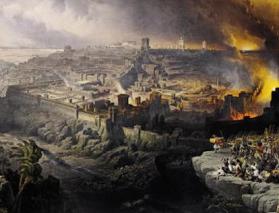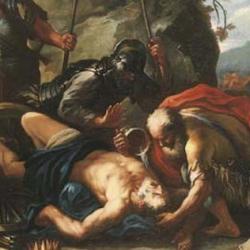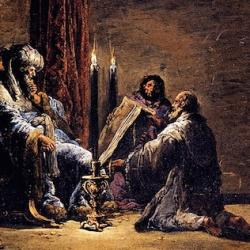In her study of Leviticus as Literature, Mary Douglas notes the “house that Jack built” quality of the Levitical descriptions of sacrifice. Priests put animal parts on the wood that is on the fire that is on the altar. Douglas takes this as a sign that Leviticus describes sacrifice as a “construction” within the altar. A small tabernacle is reproduced – the animals representing priests, the wood the tabernacle itself, formed around Yahweh’s fiery presence.
The Chronicler borrows the same stylistic flourish to describe Huram-abi’s construction of the two bronze pillars set at the doorway of Solomon’s temple (2 Chronicles 4:12-13):
1) Two pillars.
2) Bowls and capitals on top of the pillars.
3) Two networks to cover the bowls of the capitals on top of the pillars.
4) Four hundred pomegranates for the two networks to cover the bowls of the capitals on the pillars.
The order moves vertically, and moves from structural features to ornamental features. Pillars, then capitals on the heads of the pillars, then chains/networks to adorn the heads of the pillars, then pomegranates for the networks/chains. Pillars could exist without capitals, capitals without networks, and networks don’t need pomegranates.
The analogy with Leviticus perhaps indicates that the pillars are replicating the structure of the temple as a whole. The Chronicler’s initial description of the temple moves from the porch (outside, earth) to the nave to the most holy place (interior, heaven). That provides a rough parallel with the construction of the pillars: pillar (corresponding to porch and perhaps nave) to capital (corresponding to the most holy place. This connection is strengthened by the claim (3:16) that the chains on the capital of the pillars were made “in the inner sanctuary.”
We might force (or nudge) the analogy with Leviticus and see the pillars as an architectural representation of sacrifice. The pillars are bronze, like the altar, and set on the ground. They extend upward, like sacrificial smoke, to an adorned capital that is linked to the most holy place. The last thing Huram adds are “pomegranates” (rimmon), a fruit most prominent in the Song of Songs (4:3, 13; 6:7, 11; 7:12; 8:2). At the top of the pillars one finds the fruit of love; ascending in sacrificial smoke, the worshiper enters the inner chamber of the Husband of Israel, to enjoy a love feast in His throne room.















